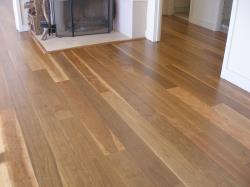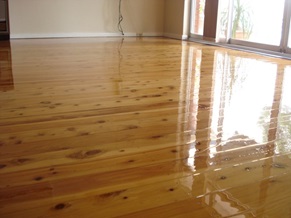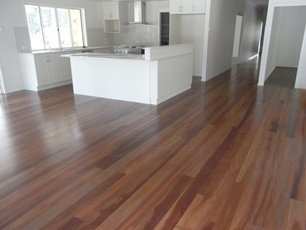Timber floor finishes
posted: 06/May/2015

A timber floor is a big investment so you need to ensure that the finish that you choose is appropriate for:
- the gloss level that you want – matt, high gloss or low sheen?
- the type and age of the timber – hardwood or softwood? New floor or re-sanding?
- the type of traffic the floor needs to handle – kids in the kitchen or a formal lounge?
- the environment – in Queensland our wet & dry seasonal changes can cause board movement after installation
- the odour –will you be living in the house during application?
There are four broad types of timber finishes available.
Oil based timber finishes
These finishes provide a natural look and are blends of natural oils and waxes with added chemical salt ‘driers’ or are curing oils such as ‘Tung’ or ‘linseed’, dissolved in mineral turpentine or white spirits, contain added chemical curing agents called metal driers.
- Least wear resistance - frequent maintenance
- Darkens with age, slow to cure in cold weather
- Unlikely to edge bond boards*
- Matt to gloss
Solvent borne polyurethane timber finishes
This coating type provides the highest durability and film build (% solids) of all coating types as well as the highest gloss levels for the gloss options. However, there is a strong solvent smell on application and they are also of highest toxicity (isocyanate content) until the coating has cured. These coatings are often selected as they provide the best wear resistance or durability resulting in lower maintenance, can be used with fast dry sealers, provide the highest gloss and film build option, are of intermediate cost and generally provide trouble free application.
- High wear resistance
- Darkens with age
- Reduced risk to edge bond boards when applied over appropriate sealer*
- Matt to very high gloss


The higher the gloss, the more evident minor surface blemishes
Composite (mix of oil based & solvent borne polyurethane) timber finishes
These spirit based solventborne coatings combine an oil with a smaller amount of a urethane. Essentially they represent a coating that is reasonably durable and generally free from potential concerns such as edge bonding.
- Less wear resistance - frequent maintenance
- Darkens with age
- Unlikely to edge bond boards*
- Matt to gloss
Water borne timber finishes
These coatings are often selected based on being a healthier option for both contractor and premises occupier due to the absence of any strong solvent smells on application..
- Moderate to high wear resistance
- Less darkening with age
- Unlikely to edge bond boards when applied over appropriate sealer*
- Matt to gloss
*Edge bond boards – this relates to the finish acting as an adhesive and bonding board edges together. When and if floor boards shrink, this can result in wide irregularly spaced gaps at the edge of the boards or splitting of boards.
Previous Articles
Nowadays you might consider the origin of the food you consume, or even the conditions in the factories your clothes are produced. But have you ever thought about where the wood for your homes floor, walls, frame or deck comes from?
So you're choosing timber and you think the choice is pretty simple - you'll need hardwood for the tough jobs and softwood for lightweight roles. Right? WRONG!
Welcome! No matter if you are a builder or architect, a DIY renovator or planning your dream new home build you’re in the right place to be informed and inspired about the use timber.